#arabian paganism
Text
The person who re-blogged this wants you to know that they are open to questions regarding their spiritual path, witchcraft and faith, and in fact, would love to talk about their spiritual path with you and have a casual talk!!
(this applies to me pspspsps HMU , don't hesitate, i am always open to respectful discussion of our spiritual paths and just being friends!!)
#witchcraft#paganism#pagan#deity work#spirituality#witch#mythology#witches of tumblr#witchblr#demonolatry#eclectic witch#folk witchcraft#witch community#witch blog#hellenic pagan#arabian paganism#roman paganism#slavic mythology#slavic#slavic paganism
441 notes
·
View notes
Video
youtube
Religion in Pre-Islamic Arabia
#religion#history#ancient religions#paganism#wathanism#arabian paganism#arabian polytheism#pre-islamic arabia#let's talk religion#documentary#video#divinum-pacis
37 notes
·
View notes
Text
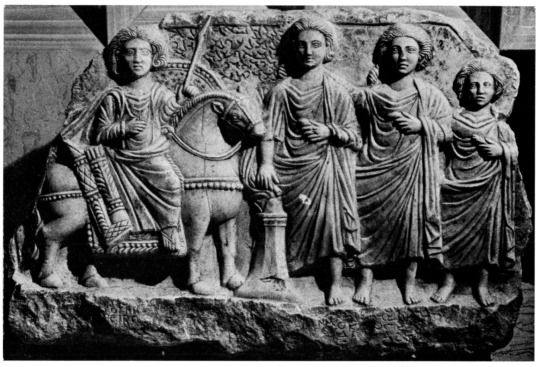
Monimos, Munim, "The Good and Bountiful Genius (GNY, Jinn)"
Khirbet Farwan, Syria
c. 100 CE?
Source: The Pantheon of Palmyra by Javier Teixidor, 1979
See also: J. Starcky's article in Semitica 22 (1972)
#munim#monimos#arso#ginaya#jinn#Khirbet Farwan#arab#arabian gods#canaan#canaanite gods#phoenicia#phoenician gods#aram#aramean gods#syria#syrian gods#levantine gods#mesopotamia#mesopotamian gods#pagan gods#polytheism#archeology#magic#witchcraft#occult
27 notes
·
View notes
Text
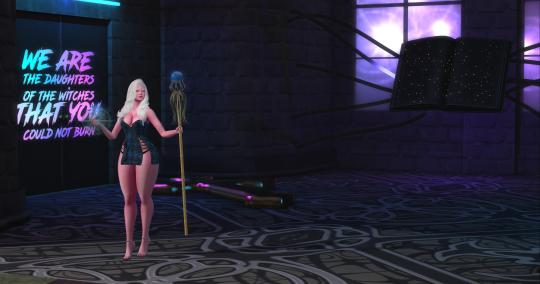
[Ari-Pari], Arabian Fashion, Pagan Beauty, Ritual Event, Stealthic, The Bearded Guy
Blog: https://aerlinnielfantasy.blogspot.com/2023/07/daughters-of-witches-you-could-not-burn.html
Flickr: https://www.flickr.com/photos/aerlinniel_vella/53077768895/in/dateposted/
#second life#secondlife#slblogging#the bearded guy#[Ari-Pari]#Arabian Fashion#Pagan Beauty#Ritual Event#Stealthic#The Bearded Guy
1 note
·
View note
Text

Anthony Fineran (B 1981), Allat Arabian Paganism, 2023
0 notes
Note
I could just look this up but I think it's more interesting to ask actual people about these things, so apologies
As a person who knows nothing about Islam, I gotta ask - what's the deal with the giant black cube?
Oh man I love talking about our cube! The cube is called the Kaaba, which means ‘the cube’. It is very holy (you are meant to be visualising it as a sort of aiming point every time you pray) but it isn’t secret, and a lot of people assume it is inherently mysterious.
So many pre-Islamic Arabian cities, including Mecca, had a cube. These served as public shrines and housed idols of the pagan gods of that city. A lot of them also housed or had embedded into them meteorites, because something falling from the sky is pretty easy to worship.
Our cube, the cube, is believed to be the site where way back in the day Ibrahim (Abraham, if you want) built a house of worship to God. Over time as monotheism lost out to pagan polytheism its original purpose was lost and people use it as a shrine and copy the form of that shrine elsewhere.
For any Muslim narrative, one of the things that Muhammad does as a prophet is to kick Arabia back onto the monotheism from which it had fallen away (into ignorance, jahiliyyah). So when Muhammad re-enters Mecca he goes to the Kaaba and smashes all the idols inside with a staff while saying that ‘truth has come and falsehood has vanished’ - in some tellings of this he preserves a statue of the infant Jesus and Mary but places it outside. What happens next is a kind of religious compromise where he Islamifies (well, God does, but he’s the one telling Muhammad what to do) bits of the Meccan pagan religion. So the cube stays, the meteorite in it, a black stone, stays, and the Meccan fertility rite of tawaf where people circled the cube naked gets changed so you have to wear clothes and it isn’t horny any more. A mosque is built up around it. Eventually the direction you face during prayer is changed from towards Jerusalem to towards the Kaaba. And from then until now Islamic practice in relation to the cube has not really changed.
FUN CUBE FACTS
It’s not the same building Ibrahim built or the same building Muhammad resanctified. It has fallen down in earthquakes or been destroyed with catapults an alarming number of times and then just rebuilt in a very practical way. The current incarnation dates back to 1626.
It’s not black - in high winds or when it’s being changed, which it is yearly, you can see under the black and gold cloth covering, the kiswah, and see the granite blocks underneath:
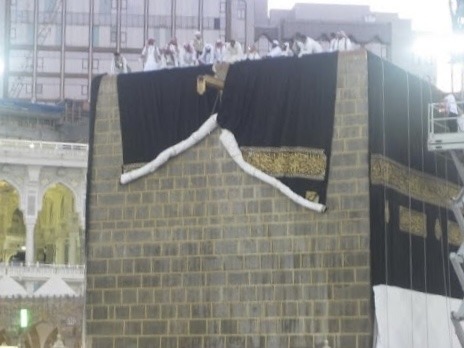
The kiswah also doesn’t have to be black. It’s a pretty firmly established tradition now but it’s been red, green and white at various times.
It has an inside. There’s nothing secret about it like the Holy of Holies, every year a bunch of dignitaries get to go in and clean it. There’s nothing material important in there, that being sort of the point:
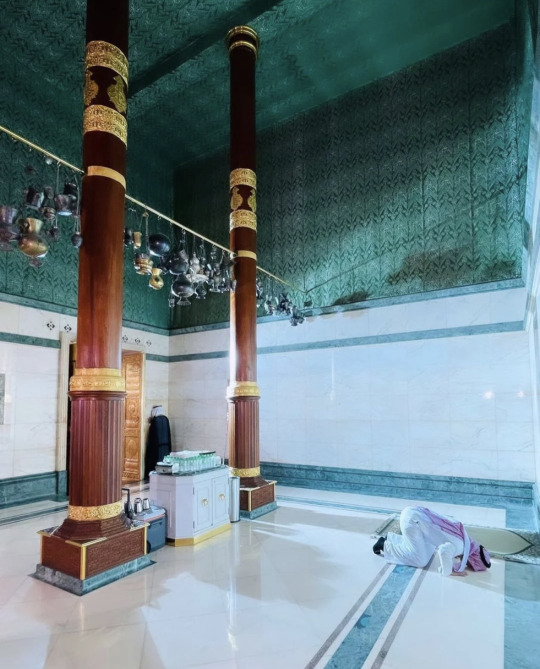
The little cabinet has cleaning supplies, perfumes and the like. If you pray inside the Kaaba you can face in any direction, plus I like to imagine you unlock a fun little achievement.
1K notes
·
View notes
Note
To clarify on the CS Lewis question, I've noticed fantasy authors tend to trash CS Lewis on religious grounds while any praise mainly comes from Christian apologists. Guillermo Delo Toro even said he refuses to read Lewis now based on his religion despite once being a fan. It's a big world out there, but offhand the only two people I can think of who speak positively about Lewis and don't make his religion the grounds for liking or disliking his work are you and Steven Moffat.
For me, reading as a kid, Lewis was a pretty ropy Christian allegorist. As a kid reading Lewis the places he sent me, excited, deeper into the library to find out more about what he was talking about, included Silenus, Bacchus, fauns, werewolves, who Plato was and what Plato's cave analogy was, naiads, dryads, maenads, Elizabethan magic and worldview with regard to things like fire elementals and ships, and into the original Arabian Nights.
Whereas the point I noticed that the dragoning of Eustace Scrub was a retelling of Paul on the Road to Damascus just made The Voyage of the Dawn Treader less interesting for me, not more. The wild fun essentially pagan magic was, in retrospect, for me as a seven year old, the joy and the heart of Narnia, while the Christian gloss, especially in the last book, always felt awkwardly imposed from outside. (It was my biggest disappointment with the Prince Caspian movie. They had taken all the gods out.)
And I think it's the undigested blobs of gloss that people, Christians and otherwise, react to badly as adults, because they feel like something from another book. Aslan as the lamb who then assures the children he has a different name in our world feels to me now like it would be more at home in something like The Water Babies. At the time, I just assumed that it meant Aslan kept an eye on this world too, and I would say a respectful hello to Lions in the zoos when I was taken to them, just to be on the safe side.
2K notes
·
View notes
Text
From my friend Hilde Vertlieb, Philadelphia PA, USA.
Now for a little lesson in actual History
In 622 Ad Mohammed was forced to flee Mecca. He and his band of followers were forced out by the Egyptian Polytheist, who did not recognize Mohammed (who was illiterate), his religion, or his fake prophet status. (By the way, while Egypt did hold Jews as slaves, Egypt did recognize Judaism).
Muhammad landed in Medina. And studied Judaism. At this time he incorporated certain parts of Talmudic Law into his newly invented religion, in the hopes of converting Jews to Islam. But the Jewish tribes of Medina, of which there were three, never accepted him as a prophet, and his Islamic Cult was seen as a religion.
So after 2 year in Medina unable to convert the Jews he declared war on the weakest tribe. Starting with the Murder of Ka'b lbn al-Aschraf.
It was said that in 624 AD, Ka'b In al-Aschraf had gone to Mecca to discover why Mohammed was expelled. And Mohammed had him Beheaded. Al-Ashraf was Chief of the Banu Oaynuqa tribe. Keep in mind Judaism was one of the original Tribal cultures, and Medina was roughly 50% jewish, 25% Christian, and 25% pagan. But he was most threatened by the (then very peaceful) Jews and so began the practice of ethnic cleansing. Muhammad ordered all the Jews killed. But his ally Abdullah In Ubayy intervened. And the Banu Oaynuqa tribe was initially spared and exiled to Edri (now Jordan).
In 625, Muhammad attacked the Banu Nadir tribe. They were date farmers. But again Abdullah In Ubayy intervened. As Muslims were not farmers. They were exiled to Khaybar. But forced to practice their religion in secret. As Mohammed permitted no religion but Islam to exist on the Arabian Peninsula. They were kept as Dhimmis and forced to pay exorbitant taxes ( tribute) to Mohammed and Islam.
Back in Medina, only one of the three Jewish tribes remained, and they were the wine makers. And in 627, after the death of Abdullah Ibn Ubbay, he laid siege to the last tribe. This tribe was absolutely destroyed, driven by Mohammed's blood lust and hatred of Jews. The Children were spared but sold off as slaves. The women were also spared but given to Muslim soldiers as sex slaves. And then Muhammad had all the 700-800 men (basically everyone who exhibited puberty, so mostly 14 and older) decapitated in the Market Place of Medina. It was said the blood of Jews flooded the Market of Medina (Muslims now claim it was a mass suicide, you know since beheading is a common suicide choice). By 627 AD Mohammed had essentially destroyed or enslaved the entire population of Jews of Khaybar (now Medina).
After his death in 637 AD all the surviving Jews were expelled to Mesopotamia, which then the Muslims again invaded, and it became Iraq, and newly created Islamic Jihadis, expelled the Jews once again.
The point is NONE OF THE LAND WAS MUSLIM, IT IS ALL OCCUPIED TERRITORY. FROM THE MANY CULTURES ISLAM DESTROYED IN THE NAME OF MUHAMMAD AND THEIR RELIGION.
I say give it all back. Stop the spread of this malignancy. And push this crew back to the only ground they can claim, which was the area around a cave near Mecca that Mohammed crawled out of.
By the way how did Mecca, the place Mohammad was first expelled, become Islam's most Holy site? Interesting question. because none of that region is the property of Islam.
By my primary concern is the Jews. The rightful heirs to not only Israel but apparently, Jordan, since at least 624 AD and Khaybar, and Judea, and on and on. Jews were never the occupiers, they were the indigenous, the ones whose land was occupied.
And when they say Jews don't exist, they are European Colonizers, remember and remind them of Islam's perpetual apartheid in the Middle East that expelled Jews (and Christians and Copts), explaining the diaspora -- and how many Jews ended up in Europe and AS THEY OCCUPIED THE JEWISH HOMELAND. While we are at it, tell the Islamist-majority body of the UN to buzz off. Their phony partitions created this mess, by letting THEIR ANTISEMITISM GUIDE THEIR DECISION TO GIVE AWAY JEWISH LAND TO ARAB OCCUPIERS.
#secular-jew#israel#jewish#judaism#israeli#diaspora#jerusalem#secular jew#secularjew#islam#mohammad#muhammad#mohammed#prophet mohammed#khaybar
34 notes
·
View notes
Text
Flag of the Kingdom of Mongolia
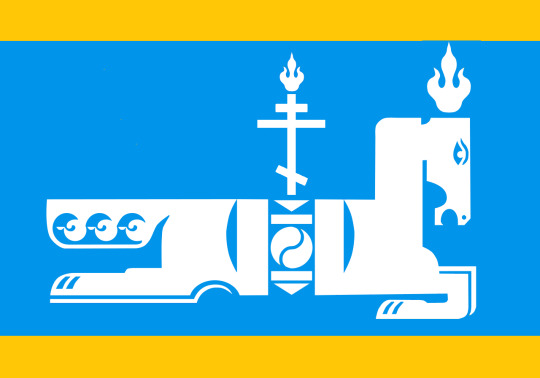
This is the flag of the Kingdom of Mongolia. It comes from a world where China successfully repelled the Mongols early on. As a result, the Mongol Empire never came to be. The Mongols continued to be pushed farther and farther west until they arrived in Eastern Europe. Eventually, they settled around where Romania and southern Poland are in our world. Thus, the Kingdom of Mongolia was born. The Mongols were frequently visited by Byzantine missionaries, and the Mongolian Orthodox Church is the official state religion. The Byzantine Empire also remains a major trading partner for Mongolia. In more peculiar alliances, Mongolia is also a major ally of the tiny mountainous nation of Neo Hellas, the final remnant of pagan Greece.
The coming of the Mongols altered the migration patterns of several other peoples. For example, the Bulgars settled in Russia, establishing the Czardom of Bulgaria. Meanwhile, several Germanic tribes invaded Greece, and Byzantium is currently ruled by a Germanic dynasty. Islam was still founded, but it never expanded beyond the Arabian Peninsula.
In terms of bad relations, Mongolia has always had a very tense relationship with the Franco-Saxon Kingdom. Throughout the years the Franco-Saxons have repeatedly attempted to conquer the Mongolians. Even after all these years, Mongolia remains bitter about the Franco-Saxon invasion that occurred during the Second Great Patriotic War. Despite this, in more recent times there has been increasing emphasis on moving on and letting go of the past. Younger generations in particular are more likely to support reconciliation between the two nations.
Mongolia takes pride in its dual mature of East Asian heritage and Eastern European culture. The flag reflects this dual heritage. The blue recalls both the cloak of the Virgin Mary and the eternal blue sky of the Tengrism. The horse symbolizes the nomadic past of the Mongolian people, before they settled in Eastern Europe. The cross represents the Mongolian Orthodox Church, with the flame representing the flames of Pentecost. The interlocking circles halves represent the dual nature of the Mongolian people. The golden bands represent the hope that the Mongolian people will always prosper no matter what life throws at them. They also help to offset the blue on the main body of the flag.
https://drakoniandgriffalco.blogspot.com/2019/03/flag-of-kingdom-of-mongolia.html?m=0
#alternate history#alternate history flag#alternate history flags#vexillology#flag#flags#mongolia#Kingdom of Mongolia#Flag of the Kingdom of Mongolia#Romania#Poland#ukraine#moldova#eastern europe#Mongols#alt history
36 notes
·
View notes
Text
a long rant about HTTYD lore
WHY THIS DATE?????
it would be much better, in my opinion, for the HTTYD franchise to take place somewhere in "The Dark Ages", like the books, and not to have a confirmed date for the first movie (that is 1010 AD), because otherwise it implies that some time into Hiccup's reign he would, for example, decide to convert to christianity as the last scandinavian country that stayed pagan converted during the events of the second film (Iceland) and it would be politically fashionable to be christians then... completely bonkers.
why they would even have chosen the 11th century? they don't portray this time like it should have been for the countries with the scandinavian culture, so why did they do this? it doesn't make any sense, this date has no meanjng in the lore of this universe, it's just an info burden.
what am i really supposed to do with this date? make William the Conqueror gather an army of dragons and dragon riders to conquest England? imagine the Bayeux tapestry in this universe. or the Dragon riders being the new honorable rank of guards at the court of Byzantium emperors instead of the Varangian guards, that would be epic. and if those ideas seem to be a total bullshit to you, i politely remind you that Scandinavia was far from isolated at the 11th century, and the island of Berk would certainly be known to all of the Northern Europe after the second film (since in the third film berkians' enemies are from all sorts of places), hence all Europe and even the Arabian Califate would hear a couple of words about the Dragon riders, because DRAGONS. although films make you think that even with such wide knowledge about the dragon-riding people that their enemies are from all parts of the world, Berk is isolated as fuck and the outer world really has no meaning to it, like Berk has no meaning to the world whatsoever. now THIS is bullshit.
now give me an 11th century french lady embroidering dragons on her husband's chemose or remove the damn date from the world's memory so that i could find peace.
19 notes
·
View notes
Text
I am. Relentless and bitter at the turnout of ancient history. As a norse pagan I have to meticulously sift trough archeology articles, museum reports and academic texts just to have any semblance of my own god damn culture and religion. (Please take this as gently as possible) I don’t want. The wishy washy mash of pagan traditions that have been smushed together and salvaged from all over the world. Learning from different cultures is good and awesome but I want MINE. MY culture. DANISH tradition, and not the christianized version of it.
Even in my own damn country most people would rather believe fucking marvel about our traditions than what actually was, and don’t even get me started on the westernized macho man bigot version of norse mythology where it’s just a sorry excuse for people to steal everyone else’s shit.
Do y’all realize one of the only complete accounts of the old Nordic funeral rite comes from an Arabian traveler who himself added in the account that the Vikings called him stupid for not understanding anything.
I do my best to not be bitter towards the religions that over shadow mine, the Christian’s alive now had no hand in stealing my traditions, all I want is my things back. They where oral traditions and sharing them became a crime, all that’s left is the monuments and the texts from foreign hands
18 notes
·
View notes
Text
I'm a pagan who worships lesser known deities, of course i am very happy when i see my deity mentioned anywhere (even as a name of a restaurant or something...)
#i know everyone does this#witchcraft#pagan#paganism#deity work#mythology#spirituality#witch#witches of tumblr#witchblr#hellenic pagan#demonolatry#roman paganism#slavic mythology#slavic paganism#norse mythology#arab paganism#arabian paganism
167 notes
·
View notes
Note
hi, i recently found your blog. as an ex-muslim also interested in paganism, can i just ask where you learnt about wathanism and if there are any specific resources on the pre-islamic arab gods that i could use to learn? i'm not arab, i'm pakistani, and i've looked into ancient subcontinental religion pre-islam, but i'd also like to learn about wathanism, since i've never heard of it before in my life despite actually looking up pre-islamic arabia's gods. thank you :)
hi hun 💕 sorry for taking forever to reply to this, i've not been very active on this blog for a lot of reasons right now. but regarding your question, i think my answer is gonna be super disappointing lol. resources are def very very limited, and a lot of what's available isn't translated (much of it is in arabic, but a lot is also in various now dead languages).
there is an english & arabic speaking community on reddit and discord dedicated to wathanism, which is really great and i'd highly recommend it. the discord has a section on books and articles, most of which are academic and peer reviewed in historical journals. since this is a religion that was largely wiped out and has very few people interested in studying it and few resources to even examine, learning about it is kind of a huge undertaking that involves a lot of niche academic texts and a lot of cross referencing.
it's a grind basically lol, but the discord is great because it's a place where people who are very passionate about reconstructing the religion will trudge through those sources very diligently, not just as a detached academic study but as a spiritual "i want to apply this in my own daily life" kind of way, ykwim? so that's very cool. i can't speak to the community too much, cause i mostly just use it as a reference point and don't talk much with people, but it's the most concentrated place of quality knowledge on the subject i know of.
the best crash course, easy to read article i personally know of on the matter is still this paper (if you copy the link into scihub you should have access to it), just bc it hits on the specific things i'm most interested in without being incomprehensible jargon. the way i practice my religion is probably not the most historically accurate tbh; for me, it's just about living by the values of respecting your community and heritage, and i think this paper does a great job of explaining why those were such important values to the old arab pagans. the people on the discord can def give you a better sense of what the practice looked like in Ye Olden Days.
also worth noting: if you're hoping to find like defined, clearly laid out mythology about the arabian gods like there are stories about norse or greek or roman gods, that's rly not what you're gonna find (at least not as far as ive ever known to exist). for the most part, the things you're gonna find are about what people valued, what rituals they had, and how they lived. the vast majority of info we have on the gods is like "people prayed for this goddess to bring good crops and for that god to protect the village," but rarely if ever are there detailed narratives or myths like there are for other old religions.
#asks#for me personally ive put learning abt religion on the back burner bc im more focused rn on modern day politics#which yk. given that my whole thing is about ancestors and heritage and animism and loving the land#politics is intrinsic to my religion and rly most of my spirituality is just an extra layer of caring about politics#(in the 'im a political secularist but deeply religious in my personal life' kinda way obviously)
5 notes
·
View notes
Text

The Good and Bountiful Genies of Bet Pas'el
Khirbet Farwan, Syria
c. 191 CE
#genie#djinn#ginaya#palmyra#Khirbet Farwan#arab#arabia#arabian gods#canaan#canaanite gods#phoenicia#phoenician gods#aram#aramean gods#syria#syrian gods#levantine gods#mesopotamia#mesopotamian gods#pagan gods#polytheism#archeology#magic#witchcraft#occult
15 notes
·
View notes
Text
The religious condition of a great city in the third century must have presented a strange spectacle. ‘Let us suppose,’ says Cumont, ‘that in modern Europe the faithful had deserted the Christian churches to worship Allah and Brahma, to follow the precepts of Confucius or Buddha, or to adopt the maxims of the Shinto; let us imagine a great confusion of all the races of the world in which Arabian mullahs, Chinese scholars, Japanese bonzes, Tibetan lamas, and Hindu pundits would be preaching fatalism and predestination, ancestor-worship and devotion to a deified sovereign, pessimism and deliverance through annihilation—a confusion in which all these priests would erect temples of exotic architecture in our cities and celebrate their diverse rites therein. Such a dream would offer a fairly accurate picture of the religious chaos of the ancient world before the reign of Constantino.’
In a modern city thus divided, every pulpit would thunder with denunciations of the soul-destroying errors taught in the next street, and the old state church, if there was one, would be most bitter of all. But at Rome the new gods fused easily with the old; no difficulty was felt in identifying a virgin goddess with the Mother of the gods. Isis could be adored as Venus, Minerva, Ceres, Diana, according to the pleasure of the worshipper. Wendland prints at the end of his book an extraordinary statuette of Fortuna Panthea, who is loaded with the characteristic emblems of Fortuna, Isis, Nike, Artemis, Asclepius, and the Dioscuri! The Oriental cults were not quite so complaisant to each other; but even in them there was borrowing, as when the lore of the Chaldæans mingled itself with the Persian religion. Paganism had no horror of heresy.
The deity, said Themistius, takes pleasure in the diversity of homage.
Paganism had no dogma and no church. It showed a kind of wisdom in tolerating Lucian, who made few disciples, and persecuting the Christians, who made many. There never was one pagan religion. The common folk maintained their simple sacred holidays through all changes till the victory of Christianity—and long after; the philosophers turned the myths into allegories and so speculated without restraint. The official religion was really dead, as dead as the republican magistracies, the titles of which were kept up for the sake of old associations. The Romans had no objection to make-believe of this kind, and distinguished men were quite ready to accept dignified priesthoods without believing anything.
-- William Ralph Inge, The philosophy of Plotinus
8 notes
·
View notes
Note
That a cool im kind of confuse about erazor djinn,merlina, time eater and the end representation
Erazor Djinn is obviously based on Djinn or Jinns from arabian mythology, aka genies. Djinn's can be good or evil just like humans, and Shahra herself is also a djinn. Of course Erazor being NAMED Djinn while Shahra is more presented as a classical wish granting Genie is deliberately being done to present the idea of a "djinn" as being inherently malevolent, while a genie is more benevolent. Considering both words are just anglicisations anyway and the original arabic word is جِنّ this is obviously a fine way to interpret it into english. Pre-islam, djinn's were essentially personal spirits that were worshiped in private as opposed to gods which were worshiped in public, although we don't have all that many historical documentation on the specifics of this. After the rise of Islam, djinns were rolled into the Abrahamic hierarchy and are on a lower rank compared to angels, and in modern mythology Djinn are essentially always portrayed as demons or evil trickster spirits (very similar to how pagan holdovers are portrayed in a negative light by christian storytellers).
Merlina is based on Merlin and also probably Morgan le Fay, as befitting of her role in the story as initially presenting herself as a mentor and guide for Sonic (who is King Arthur) only to reveal herself as the true villain and final boss as Morgan was a reoccurring antagonist of King Arthur. Given the name, Morgan was probably a fae entity of some kind and in some texts is even referred to as a nymph. Faeries in celtic and britanic tradition are a whooooole fucking thing I don't have time to get into lol. But again given christianizations tendency to take pagan traditional beliefs and incorporate it into biblical mythology for the sake of portraying it as a falsehood or evil in some way, it makes sense to take the Morgan le Fay character and portray her as this malevolent fairy creature that wants to trap the world of Camelot in a timeless limbo. That's pretty classical fae shenanigans. Once Sonic sets her straight, she recalls her Father who was Merlin with fondness while holding a flower, and Merlin is a pretty straight forward Druid (again, discounting christianization and Robert de Boron which turns him into a prophet of the holy grail). So she's definitely got a food in both circles, I'd say.
The Time Eater is pretty Lovecraftian I'd say. It reminds me of the Color Out Of Space, especially in the state we see it in before Eggman hijacks it. It is your typical eldritch entity and a being that exists outside of linear time, though I don't know if it can be said to have any specific inspirations beyond that.
The End is a God of Death and looks like the moon because various cultures viewed the moon as a symbol of death. This also puts it in stark contrast to Solaris which was a Sun God. Specifically the cycle of death and rebirth is symbolized by the moon in the way that is has difference phases of visibility throughout the year and the way those phases effect the tides. And death and rebirth is a big theme of Sonic Frontiers, particularly with the Koco and Sage's entire storyline which appropriate ends with her sacrificing herself to defeat The End before being reborn in the post credits scene. It is very similar to Dark Gaia in that it wipes the slate clean, and Tails even directly compares the power of The End to Dark Gaia in the game. Of note that in most mythologies the moon is often (but not always) presented as female, and the sun is usually (but not always) male. The End speaks with both male and female voices at the same time. It is also of course very eldritchian as well, as it only APPEARS as a moon to our mortal comprehension and we are incapable of perceiving it as it actually is, and the form that Sonic and Sage destroy is only an aspect of its true self. It is PROBABLY not inherently malevolent, just inherently destructive, and the way it is in the game is likely just because it was pissy over being imprisoned for countless eons and not perceiving mortality as having any inherent value which again speaks very much to Lovecrafian influence.
5 notes
·
View notes